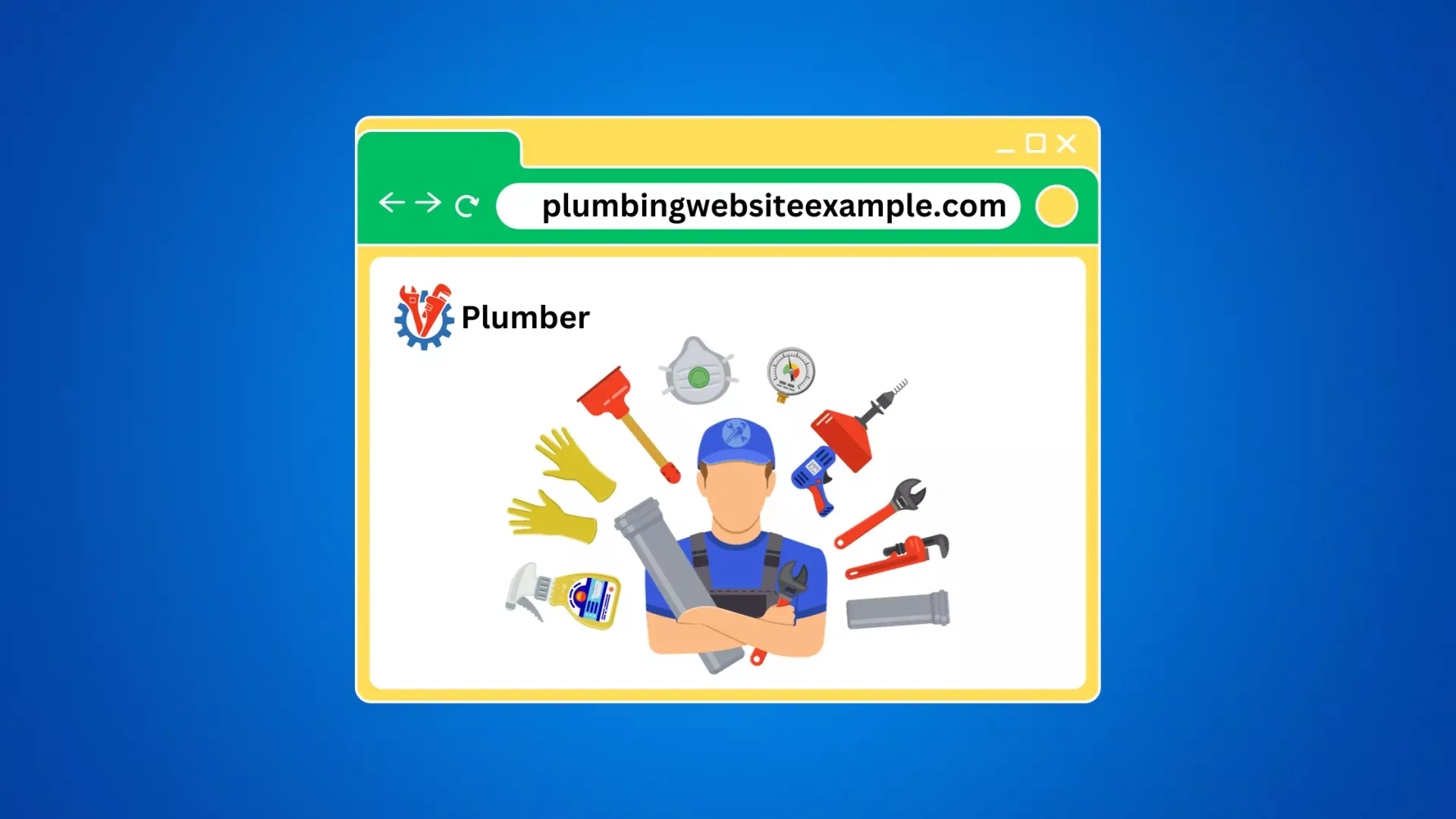Imagine a plumbing business without a website. Now, picture potential customers searching online for a reliable plumber in their area. What they find are your competitors, with professional websites showcasing their services, customer reviews, and easy contact options. You, on the other hand, remain invisible, missing out on a vast pool of clientele. Today, having a solid online presence is no longer a luxury but a necessity for any business, and plumbing is no exception. This guide is your roadmap to creating a plumbing website that not only keeps you in the game but also propels your business to new heights.
Why Every Plumbing Business Needs a Website?
Gone are the days when a mere presence in the Yellow Pages was sufficient for attracting clients. Today, people turn to the internet to find solutions to their plumbing woes. Statistics show that 97% of people search online to find a local business, and 68% of online experiences begin with a search engine.
If you’re not online, you’re missing out on a massive market share. Your website is your 24/7 sales representative, working tirelessly to attract, engage, and convert potential clients. It’s a digital business card, a showcase of your skills, and a platform to communicate your brand’s reliability and trustworthiness.
What to Expect in This Guide?
In the pages that follow, we will walk you through the process of creating a plumbing website that not only reflects your business but also ensures it thrives in the digital landscape. We will explore the foundations, content creation, online visibility, maintenance, and security that make for a successful website.
By the end of this guide, you’ll acquire the knowledge and tools to create a plumbing website. It won’t just sit idly on the web but actively drive your business forward, attracting new clients and solidifying your position in the plumbing industry. So, let’s get started on your journey to a thriving online presence.
1. Setting the Foundation:
Creating a plumbing website is an essential step in expanding your business. But before diving into the technicalities, let’s set the foundation right. Your website’s success hinges on understanding your target audience, defining your website’s purpose, and choosing the perfect domain name.
Understanding Your Target Audience
First things first, to create an effective plumbing website, you must know your audience inside out. Are they homeowners in need of emergency plumbing services, or are they contractors seeking wholesale supplies? Understanding their needs and preferences will shape your website’s content and design.
For instance, if you primarily cater to homeowners, your website should emphasize reliability, trustworthiness, and the ability to handle plumbing emergencies. On the other hand, if your focus is on serving contractors, the site should highlight your extensive inventory and competitive pricing.
Defining Your Website’s Purpose
Now that you know your audience, it’s time to pinpoint the purpose of your website. Is it primarily an online brochure for your plumbing services, or will it serve as an e-commerce platform for plumbing supplies? Having a clear purpose ensures that your website caters to your audience’s needs.
Let’s take an example: If your goal is to showcase your plumbing services, your website should feature service descriptions, testimonials, and easy contact options. However, if you aim to sell supplies, the focus should shift to product listings, secure payment options, and detailed product information.
Choosing the Right Domain Name
our domain name is your digital address, and it should reflect your brand and purpose. Opt for a name that’s easy to remember, relevant to your plumbing business, and contains a relevant keyword. For example, “PlumbProsServices.com” clearly conveys that you’re a plumbing service provider.
In contrast, a domain name like “JohnsRandomStuff.com” doesn’t provide the same clarity and relevance. It’s crucial because an appropriate domain name can significantly impact your website’s search engine rankings.
So, before you dive into the technical aspects of creating your plumbing website, take the time to understand your audience, define your website’s purpose, and choose a domain name that resonates with your brand and services. These initial steps lay a solid foundation for a successful online presence.
2. Website Essentials:
Now that we’ve established a strong foundation for your plumbing website let’s delve into the essential aspects of creating an effective online presence. In this section, we’ll explore the key elements you need to consider:
Selecting a Hosting Provider
Your hosting provider is like the engine that powers your website. It’s essential to choose a reliable one. For example, popular providers like Bluehost or SiteGround offer high uptime percentages, ensuring your website is accessible to your audience around the clock.
Designing Your Plumbing Website
Design is crucial. You have a choice: go professional, company or do it yourself. A professional web development agency can create a custom, polished look, but it comes at a cost. DIY options like WordPress or website builders are more budget-friendly and offer great templates.
Mobile Responsiveness
Did you know that mobile devices account for over half of global web traffic? Your website must look and function flawlessly on smartphones and tablets. Responsive design ensures a seamless user experience across all devices.
User-Friendly Navigation
Imagine your website as a virtual plumbing store. Visitors should easily find what they’re looking for. Organize your content logically, and implement clear navigation menus. This helps reduce bounce rates and keeps users engaged.
Incorporating Branding Elements
Your website should reflect your plumbing business’s brand by incorporating your logo, brand colors, and consistent fonts throughout your site. This helps build brand recognition and trust.
Optimizing for Speed and Performance
Speed matters. Research shows that 47% of consumers expect a web page to load in 2 seconds or less. To meet this expectation, optimize images, use a content delivery network (CDN), and consider caching to boost loading speed.
A well-designed and technically optimized website is the cornerstone of your online presence. These steps lay the groundwork for a successful plumbing website, attracting more customers and driving growth.
3. Content Creation
In this section, we’re diving into the core of your plumbing website’s success – content creation. Crafting engaging content is the key to capturing your audience’s attention and keeping them engaged. Let’s explore how to create content that resonates with your visitors:
Crafting Engaging Content
Homepage Content: Your homepage is the virtual front door of your plumbing business. It should succinctly introduce your services and provide clear calls to action. Consider highlighting special offers, customer reviews, and quick contact options.
About Us Page: Tell your story here. Share the history of your plumbing business, your mission, and what sets you apart. Let your visitors get to know the people behind the services.
Services Offered: Describe your plumbing services in detail. Use clear, concise language to explain what you offer, and include pricing information if applicable. For instance, if you specialize in emergency plumbing, highlight your 24/7 availability.
Blogging for Plumbers: Maintaining a blog keeps your website fresh and engaging. You can share plumbing tips, industry news, and showcase your expertise. Example: A blog post on “Top 5 DIY Fixes for Common Plumbing Problems” can attract homeowners searching for solutions.
High-Quality Images and Videos
Visual content is powerful. Upload high-resolution images of your work, your team, and any before-and-after shots. Videos, such as “How-to” guides or customer testimonials, add an extra layer of engagement and trust.
SEO Best Practices
Keyword Research: This is where you find the words your potential customers are using in their online searches. Tools like Google Keyword Planner help you discover keywords like “emergency plumber” or “water heater repair” that are relevant to your services.
On-Page SEO: Optimize your website’s pages with relevant keywords in titles, headers, and content. Make sure your website loads quickly, as page speed is a ranking factor.
Off-Page SEO: Off-page SEO includes building backlinks, getting positive reviews on platforms like Google My Business, and participating in social media. For example, encourage satisfied customers to leave reviews, boosting your online credibility.
Create compelling content, featuring eye-catching images and videos, and implement SEO best practices to ensure your plumbing website not only informs but also effectively engages your audience. This approach will attract more visitors and convert them into loyal customers smoothly.
4. Contact and Conversion:
In this section, we’ll explore how to turn your plumbing website visitors, into paying customers by focusing on Contact and Conversion elements. Ensuring potential customers can quickly get in touch and guiding them toward taking action is crucial. Let’s delve into these essential components:
Creating a Contact Page
Your Contact Page is your digital handshake. Ensure it’s easily accessible from your website’s main menu. Include essential information such as your business address, phone number, and a contact form. Real-time statistics show that having a contact form can increase conversions by up to 120%.
Lead Generation Forms
Lead generation forms are a goldmine for capturing potential customers. Consider adding forms strategically throughout your website. For example, you can place a “Request a Free Quote” form on your homepage or a “Schedule an Appointment” form on your service pages. By providing their contact information, visitors are taking a significant step towards becoming your customers.
Customer Testimonials
Nothing builds trust like customer testimonials. Share real stories from satisfied clients who’ve experienced your plumbing services. For instance, you might feature a testimonial from a homeowner who was impressed with your quick response to a plumbing emergency. Genuine testimonials can boost conversion rates by 34%.
Calls to Action (CTAs)
Effective Calls to Action guide your website visitors on what to do next. Use action-oriented phrases like “Get Started,” “Call Now,” or “Book Your Appointment.” Place them strategically throughout your website, especially after describing your services or showcasing customer testimonials. A well-designed CTA button can increase click-through rates by 62%.
By implementing these Contact and Conversion strategies, your plumbing website can transform casual visitors into valuable leads and loyal customers. It’s all about making it easy for potential clients to reach out and encouraging them to take that next step in their customer journey.
5. Online Visibility:
In the world of online visibility for your plumbing business, it’s not just about having a website; it’s also about making sure your potential customers can find you easily. Let’s explore the key elements to enhance your online presence:
Google My Business Listing
Starting with Google My Business is a must. This free tool allows you to manage your business listing on Google Search and Maps. Ensure your business name, address, and phone number (NAP) are accurate. Recent studies show that businesses with complete Google My Business listings are twice as likely to be considered reputable by consumers.
Social Media Integration
Social media can boost your visibility and connect you with your target audience. Create profiles on platforms like Facebook, Instagram, and LinkedIn. Share informative content, engage with your followers, and use it as an extension of your website. For example, post before-and-after photos of your plumbing projects on Instagram to showcase your skills.
Local SEO Strategies
1. NAP Consistency: Consistency is the key here. Ensure your business name, address, and phone number are identical across all online platforms, from your website to social media to local directories. A 2019 survey found that inconsistent NAP information is a common reason for business listings not ranking well.
2. Online Reviews: Encourage satisfied customers to leave online reviews. Positive reviews not only boost your credibility but also influence your local search rankings. Statistics show that 91% of consumers trust online reviews as much as personal recommendations.
3. Local Citations: Citations are mentions of your business name on other websites, even if they don’t link to your site. These citations build your online authority. Ensure your business information is listed accurately in local directories like Yelp, Yellow Pages, and industry-specific websites.
By optimizing your online visibility through Google My Business, social media integration, and local SEO strategies, you’ll make it easier for potential customers to find your plumbing services in their time of need. These steps will help your business stand out in the crowded online marketplace.
6. Maintenance and Security:
Maintaining the health and security of your plumbing website is an ongoing task that’s as crucial as the initial setup. Let’s explore the key aspects of ensuring your website’s longevity and safety:
Regular Updates and Backups
Just like plumbing systems need regular maintenance, websites need it too. Keep your website software up to date. This includes your content management system (e.g., WordPress), plugins, and themes. Regular updates help ensure that your website runs smoothly and remains secure.
Consider this as akin to periodic checks on your plumbing infrastructure. Neglecting updates can expose your website to security vulnerabilities. A study found that 56% of website breaches occurred due to outdated software.
Additionally, maintain regular backups of your website. This is like having a backup plan for potential plumbing emergencies. Backups ensure you can quickly restore your site if something goes awry, preventing data loss and downtime.
Ensuring Website Security
Online security is paramount. Protect your website from threats with security plugins and robust passwords. Regularly scan for malware and potential vulnerabilities. For instance, a strong password can help prevent unauthorized access. Did you know that 65% of people use the same password for multiple sites, making them vulnerable to hacking?
Handling Technical Issues
Technical issues are inevitable, much like plumbing problems. Be prepared to handle them swiftly. Monitor your website for errors and broken links. Utilize tools like Google Search Console to identify issues. Having a plan in place for addressing these issues ensures your website stays operational and user-friendly.
Remember, a website with regular maintenance and strong security measures is more likely to rank well on search engines and provide a positive user experience. Just as a well-maintained plumbing system ensures a leak-free home, a well-kept website ensures a seamless online presence.
In conclusion, A professional plumbing website is not just a powerful tool that can transform your business in the real world. Just as a well-planned plumbing system ensures the smooth flow of water, a well-designed website ensures a steady flow of customers.
The Power of a Professional Plumbing Website
Your website is your 24/7 virtual storefront, always open to potential clients. It’s the first impression many people have of your business. An impressive website, complete with engaging content, striking visuals, and easy navigation, not only attracts visitors but also converts them into loyal customers.
Consider the statistics: Businesses that maintain an active blog receive 55% more website visitors. That’s a substantial increase in potential clients right at your digital doorstep. Moreover, 88% of consumers who search for a local business on their mobile device call or visit that business within 24 hours. Your website can be the catalyst for these calls and visits.
Next Steps for Your Plumbing Business
Now that your plumbing website is set up, your next steps involve continuous growth and improvement. Keep your content fresh, continue building your online presence, and engage with your audience through social media. Maintain your website’s security, and consistently monitor your site’s performance.
Your professional plumbing website is more than an online presence; it’s the digital anchor of your business’s success.






